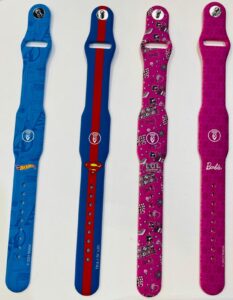By Terrie Smith, Co-Founder and CEO, DIGISEQ
1. Please tell us a bit about yourself
My career in payments spans 20 years, with leading roles in digital and mobile payment service development at companies including IBM and MasterCard, where I was responsible for several pioneering technology patents.
At MasterCard, I led the development of the Mastercard Digital Enablement Service (MDES), which is the backbone of mobile contactless payment services like Apple Pay and Google Pay. Colin Tanner, DIGISEQ’s Chief Technology Officer, was previously Business Leader at MasterCard developing Mobile PayPass issuance.
Having seen the potential of this technology, which marries contactless and mobile payments through secure tokenisation, we were inspired to co-found DIGISEQ in 2014 to bring wearable tech mainstream. Today I lead the company as CEO, and Colin is the inventor of our trailblazing technology mobile personalisation (RCOS™), which enables payment data to be delivered to any wearable object directly via the consumer’s Android or iOS mobile device.
2. Talk to us about DIGISEQ. Which product or service do you offer, and what differentiates DIGISEQ from its competitors?
DIGISEQ is the world’s first tokenised wearable payments service, enabling wearable tech users to pair their bank card to their item, track their activity, and select which payment features to use, giving them complete control. This is done through DIGISEQ’s Manage MiiTM mobile app, which can be white-labelled with the branding of clients, essentially making us an invisible payments partner for banks, payment schemes and brands.
Unlike active wearable tech such as smartwatches with limited battery lives, with tokenised wearable tech, virtually any form factor – like a ring, key tag, even a bracelet charm – can be inserted with a chip and turned into a contactless payment or digital ID token.
DIGISEQ’s wearable tech combines the convenience of contactless payment and secure digital ID to protect against lost and stolen cards, fraud and ID theft – all in one wearable item that goes wherever the user goes, with no PIN required, and real-time tracking for added security.
Through our mobile personalisation (RCOS™) technology, DIGISEQ securely provisions payment data over-the-air to customers’ iPhone or Android mobile devices, so users can activate their own wearable item in their comfort of their home, without needing to wait for their bank or any other issuer to do it on their behalf.
DIGISEQ’s mobile personalisation and tokenisation ensures all provisioned prepaid or tokenised payment data is fully protected, with contactless transactions secured in exactly the same way as card or phone NFC payments.
3. How is wearable tech improving experiences for banks and brands?
Many businesses have previously been deterred from offering wearable tech due to perceptions about high costs and complexities. DIGISEQ’ passive wearable tech solution changes all that, because it combines the convenience of contactless payment, secure digital ID, and tokenisation.
DIGISEQ connects an entire ecosystem, serving as the link between banks, product creators, retailers, chip manufacturers and service providers.
Previously, any chip-enabled item, like a plastic card or other form factor, requiring personalisation or provisioning with user data, would need to go through the costly, time-consuming process of being personalised by the manufacturer before being delivered to the brand, and then delivered to the user.
DIGISEQ handles the personalisation and payment enablement of the wearable item from end to end, without the need for the manufacturer or even the brand to do anything beyond embedding the NFC chip into the wearable item. This saves huge amounts of time and money, and means the item can delivered faster to the user. We do the heavy lifting on behalf of businesses and clubs to ensure that items get to users and can be activated by them as quickly as possible.
DIGISEQ’s wearable tech and services are already being used to great effect in sports and entertainment venues, dramatically speeding up entry times with encrypted ID for secure access, and fast contactless payments inside venues. Additionally, our wearable items can be provisioned with special promotional offers that can be used in real time, incentivising even more usage and providing a truly immersive and unforgettable user experience.
In fact, our technology is already being used by major banks like ABN AMRO, luxury brands like Philippe Starck and at prestigious events, including the 2019 Golden Globes Awards. Over the last 12 months, DIGISEQ’s wearable tech has enjoyed a successful partnership with Spanish La Liga football club Real Betis. Most recently, DIGISEQ was chosen by German mobile payment app VIMPay to allow any German bank customers to use their wearable item to make contactless payments worldwide, through prepaid or tokenised payment accounts.
By promoting use of wearable tech, banks and brands can significantly reduce their reliance on producing and personalising plastic cards, improving their environmental and sustainability efforts. All data is sent digitally to the user’s item, eliminating the need for plastic cards or paper tickets.
4. How has the pandemic affected the use of wearables?
People worldwide were already shifting to non-cash payment methods like contactless cards and mobile payments before the pandemic struck. As contactless payments have surged in direct response to the pandemic, it’s created the ideal environment for wearable tech to become an everyday part of consumers’ lives.
The secure provisioning of payment credentials into a ring, a wristband, a fitness tracker or pretty much any accessory, is as easy as a tap on a smartphone or card.
5. DIGISEQ recently announced it has secured an undisclosed investment. Can you elaborate on the investors? What was it about their experience that appealed to DIGISEQ, and how was the investment secured?
The investment comes from Rtekk, a fintech-focused portfolio company of Investcorp, a leading global alternative investment firm with $41.2 billion of assets under management. Rtekk has established a market-leading position of investing in lower mid-market technology companies with a specific focus on the data analytics, IT security, fintech and payment sectors.
This initial backing of an experienced investor like Rtekk is the first of many clear signs showing the massive potential of DIGISEQ’s ground-breaking technology, which can be used in every conceivable scenario where payment transactions and identity verification could be used. The potential use cases for DIGISEQ’s tech span payments, identity and secure access, and digital trustmarks for goods like apparel, artworks and collectible items.
6. How will the funding be used to enable company growth and what will be DIGISEQ’s primary focus post-investment?
The investment will be used to accelerate DIGISEQ’s rapid expansions plans as demand for our wearable tech surges amongst bank issuers, payment schemes and sports venues worldwide.
With the backing of Rtekk, the benefits of our pioneering technology, which creates the perfect blend of convenience, security and engagement, can be brought to even more people and organisations globally. We’ll be using the investment to expand our Object-as-a-Service and RCOS™ services to payment schemes, banks, and other issuers.
7. What are the key trends and opportunities in the wearables space?
For sports venues, one of the biggest sources of fan frustration is queuing. Nobody likes being made to wait in lengthy queues to access the stadium, or miss any in-person action because they’re stuck in a long line at a counter to get food, drink or fan merchandise. And for clubs and venue owners, ensuring that ticketholders are correctly identified – and eliminating the possibility of counterfeit tickets being granted access – are top operational priorities.
Wearable tech solves some of the biggest challenges that sports venues have to deal with, by dramatically speeding up entry times with encrypted ID for secure access, and fast contactless payments that reduce the need to fumble around in pockets or bags for cash.
Since the introduction of our technology, football club Real Betis has seen a 50% rise in average stadium attendance, and now currently boasts an average attendance of 48,000 – the fourth-highest in Spain. This is a prime example of how wearable tech is creating limitless opportunities for the future of stadium access, payment options, and drawing fans closer while also boosting revenues.
For banks, issuers, and other brands like retailers, wearable tech empowers them to get closer to their customers, through stylish and aspirational items that go with them wherever they go. By making contactless payments and digital ID even more convenient with wearable objects, banks and other businesses can drive up transaction volumes, increase app engagement, and get a granular view over their customers’ everyday payment behaviour with real-time tracking.
There’s no limit to the possibilities that wearable tech can create for people to engage with their favourite brands, and the opportunities to forge even deeper, real-time interactive connections will transform user experiences in ways we haven’t even begun to imagine.
8. What do you predict is the future of wearables?
Having seen how the world moved beyond plastic cards to mobile, the world is now moving beyond mobile, with millions of objects intersecting and connected for consumer needs. There’s no doubt the world is getting more digital by the day, and data can now be provisioned into a tiny chip that can be invisibly integrated into a wide range of items in various shapes and sizes, from high-end fashion items, collectible merchandise and unique items like artworks to stop counterfeit fraud.
The wearable payment devices market is anticipated to grow at a CAGR of 29% between 2022-2032, with an estimated market valuation of US$13.43 billion just in 2022 alone. This is being driven by the rapidly growing Internet of Things network connecting payment applications, access control and brand consumer engagement across an expected 41 billion devices by 2027.
I’m hugely excited by the potential of wearable tech to give people even more choice and convenience in how, when and where they can pay, without compromising on an individual’s style. I’m proud that DIGISEQ is playing such a transformational role in embedding payments and wearable tech more easily and intuitively into people’s everyday lives.



